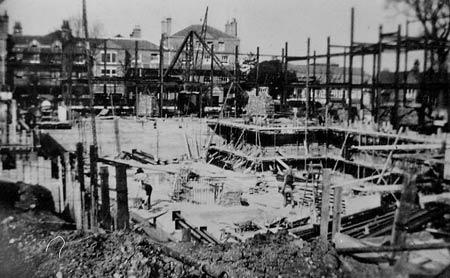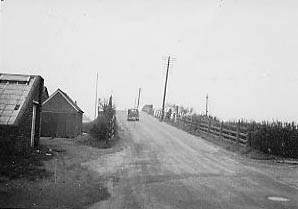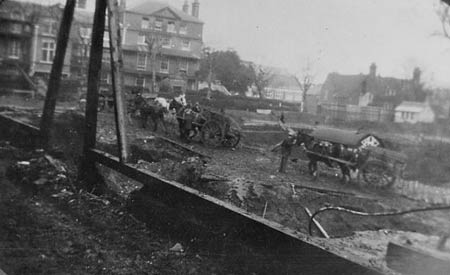|
This article was first published in the West Sussex Gazette on 30th June 1994.
The last compelling chapter in the young years of Peter Longhurst revealed what life was like in Swandean Isolation Hospital and how youngsters had tonsils removed in the years leading up to World War II. This week, the story continues with tales from the early 1930s.

Municipal construction work: The new town hall going up, viewed looking north towards Stoke Abbot Road and the Convent of the Holy Rood which was demolished a little later and replaced by Stoke Abbot Court. Building worker George Longhurst slipped from the scaffold pictured here, seriously injuring an ankle.
photographed on 4th March 1932 by the late John Shaw who worked in the local authority rates dept.
|
When the new town hall was being built in Chapel Road during 1932/3 it provided work for many locals, including Peter's father, who injured an ankle erecting scaffolding. 'Whilst putting up wooden scaffold poles and tying them in with rope, he slipped and fell.' As a direct result of that injury, he was refused entry into the armed services some years later when the country was in the grips of World War II.
When the newly-built town hall was officially opened on Monday 22 May 1933 by Prince George, seven-year old Peter and his buddies spotted him in East Worthing. 'He came in a convoy of three shiny black cars over Ham Bridge. I don't know why he came that way. We saw him and waved. He waved back.'

Rural 1930s setting: Looking north towards the old Ham Bridge over the railway at East Worthing, with no pavement.
photographed by the late Eric Sparks
|
Off Norfolk Street on the east side of Victoria Park existed an abattoir for many years. Young Peter and his mates used to watch cattle being driven there after being transported to the town by railway. 'We would watch them being unloaded from cattle trucks into pens on the north-east side of Broadwater bridge, the old one that is, and being herded over the bridge and past the old first world war tank that stood by the other side, and along Teville Road towards the slaughterhouse.'
Peter's family moved from Clifton Road to East Worthing in the later 1930s. 'It was a dark evening shortly after Bonfire Night. I remember it well, for it was our first home to be lit by electricity --- but there were no bulbs there. Fortunately, a good-hearted neighbour, a lady by the name of 'Bubbles' Archer, came to the rescue armed with one bulb and a coin for the slot meter.'
Upon moving there he transferred from Holy Trinity to Dominion Road School where the headmistress was Miss Lazenby, and he recalls a teachers name was Miss Babbage, but I won't tell you what her pupils used to call her, suffice it to say that her name rhymes with a common vegetable. Peter sang with the school choir, competing against others at the Assembly Hall and at a venue on Bognor seafront. Peter also sang for the Holy Trinity church choir, being paid eight shillings per quarter for two Sunday services and one evening a week choir practice.
But there was much more to life than school and choir-singing. In the next part of this Peter Longhurst series, he will be recalling pre-war days when the station at East Worthing was Ham Bridge Halt and the old narrow bridge there had no pavement; and furthermore he will be disclosing some high jinks in which he and his mates indulged.

Horsepower: Carting out soil on Corporation carts from the proposed strong room of the new town hall, viewed looking north towards the Convent of the Holy Rood in Stoke Abbot Road (demolished since and replaced by Stoke Abbot Court), Rivoli Buildings at the junction with North Street (taken for road widening), and Havercroft Buildings at the Chapel Road junction (still there today).
pictured on 19th November 1931 by amateur photographer the late John Shaw of Navarino Road
|
| |


